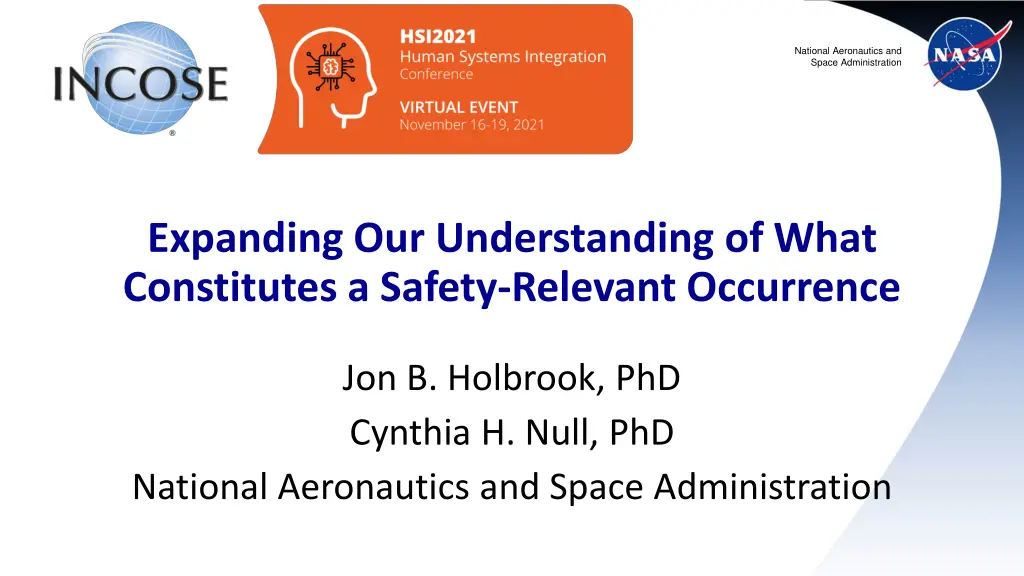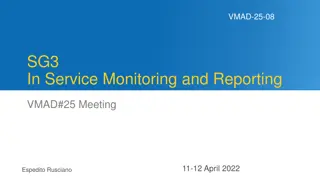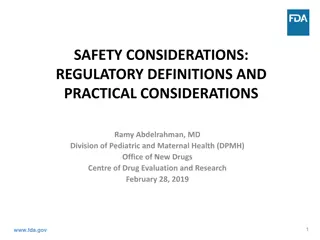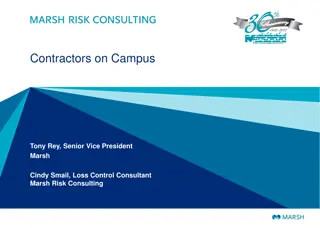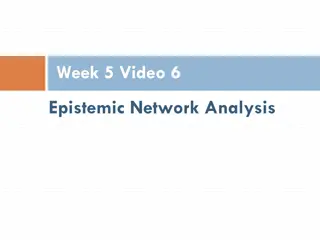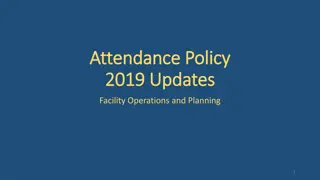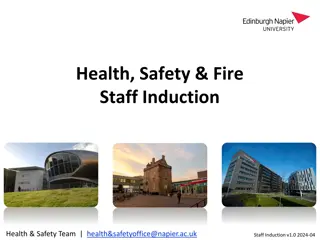Safety-Relevant Occurrences: Insights and Expansion
This study by Jon B. Holbrook, PhD, and Cynthia H. Null, PhD from NASA, delves into broadening perspectives on safety-critical incidents. It explores the evolving understanding and implications of safety-relevant occurrences for enhanced risk management.
Download Presentation

Please find below an Image/Link to download the presentation.
The content on the website is provided AS IS for your information and personal use only. It may not be sold, licensed, or shared on other websites without obtaining consent from the author.If you encounter any issues during the download, it is possible that the publisher has removed the file from their server.
You are allowed to download the files provided on this website for personal or commercial use, subject to the condition that they are used lawfully. All files are the property of their respective owners.
The content on the website is provided AS IS for your information and personal use only. It may not be sold, licensed, or shared on other websites without obtaining consent from the author.
E N D
Presentation Transcript
National Aeronautics and Space Administration Expanding Our Understanding of What Constitutes a Safety-Relevant Occurrence Jon B. Holbrook, PhD Cynthia H. Null, PhD National Aeronautics and Space Administration
The importance of thinking about safety thinking Safety Policies & Decision Making Safety Thinking Affects Affects Affects Data Collection & Analysis Learning Affects 2
Example: How safety thinking affects safety policies Humans produce safety far more than they reduce safety Human error has been implicated in up to 80% of accidents in civil and military aviation1 Pilots intervene to manage aircraft malfunctions on 20% of normal flights2 World-wide jet data from 2007- 20163 244 million departures 388 accidents Learn more: Holbrook, J. (2021). Exploring methods to collect and analyze data on human contributions to aviation safety. In Proceedings of the 2021 International Symposium on Aviation Psychology. https://aviation-psychology.org/wp-content/uploads/2021/05/ISAP_2021_Proceedings_FINAL.pdf 3 (1) Weigmann & Shappell, 2003; (2) PARC/CAST, 2013; (3) Boeing, 2017
Absence of evidence evidence of absence A Debatable Claim: To fast-forward to the safest possible operational state for vertical takeoff and landing vehicles, network operators will be interested in the path that realizes full autonomy as quickly as possible. (Uber, 2016) When we characterize safety only in terms of errors and failures, we ignore the vast majority of human impacts on the system When policy decisions are based only on failure data, they are based on a very small sample of non-representative data Removing the only demonstrated reliable source of safety-producing behavior without first understanding the capability being removed introduces unknown risks 4
Cultivating a Culture of Continuous Learning Learning only from rare events means that learning only occurs rarely Continuous learning requires learning from everyday work, not just exceptional work Continuous learning expands our opportunities to collect, analyze and act upon safety-critical insights # of events Undesired events Performance 5
Identifying What Constitutes a Safety-Relevant Event (1 Nearly all work activities end well ) Routine operation Work that precedes both successful and failed outcomes often occurs in much the same way (2 Distance from ) Early Safety Limit intervention (3 (4 ) Near Miss; Close Call Continuous learning requires learning from what goes well, not just what fails ) Accident (loss, harm) Typical Criterion for Safety Analysis Time 6
Opportunities for Learning Learning is a consequence of interactions between people and their environment People are learning (almost) all the time Learning can be structured and deliberate, but also unstructured and implicit Organizations can influence people s learning Creating Knowledge Retaining Knowledge Transferring Knowledge 7
Benefits of Learning from Everyday Work Does not have to wait Builds on what is already strong Helps organizations recognize slow changes Helps organizations respond before unwanted events occur Helps organizations understand the adaptations personnel make to keep the system operating Can involve everyone 8
Changing our safety thinking Expands understanding of what constitutes a safety-relevant occurrence Creates new opportunities for collection and analysis of safety- relevant data Learn from factors that contribute to desired states, not just undesired states Learn from routine performance, not just exceptional performance Potential to increase sample rate, sensitivity, and timeliness of safety learning 9
Collecting/analyzing safety-producing behavior data Human performance Includes both desired and undesired actions Represents a significant source of aviation safety data Operator-generated data Observer-generated data System-generated data Human-in-the-loop (HITL) simulations 10
Identifying Useful Sources of Data What data about safety-producing behaviors can we collect and analyze? What data do we already collect, but could analyze differently? What data could we collect and analyze, but do not? Operator-, observer-, & system-generated data How can we measure the productive safety capability of a system? How do operators prevent, prepare for, and recover from failure? How do operators create and leverage safety-building opportunities? How does the design of the system (hardware, software, training, procedures, policies, etc.) support or hinder exercising these capabilities? 11
Implications for system design When designs are focused on failure alone Improve safety by minimizing human roles Protect the system from error-prone humans System designs should Acknowledge human limitations and the consequences of human error AND leverage the capabilities of humans to create and sustain safe operations Challenges and opportunities for system design that leverage human capabilities and new ways of thinking about safety 12
Key Take-Aways Individuals are (almost) always learning Organizations can affect the creation, retention, and transfer of knowledge When we characterize safety only in terms of errors and failures, we ignore the vast majority of human impacts on the system When we systematically restrict opportunities to learn, not only do we learn less and less often, but we can draw misleading conclusions Many opportunities exist to collect and analyze largely unexploited operator-, observer-, and system-generated data on desired behaviors Identifying, collecting, and interpreting data on operators everyday safety-producing behaviors is critical for developing an integrated safety picture 13
References Abel, M., & B uml, K.-H. T. (2013). Adaptive memory: The influence of sleep and wake delay on the survival-processing effect. European Journal of Cognitive Psychology, 25, 917 924. Bellezza, F. (1981). Mnemonic devices classification, characteristics and criteria. Review of Education Research, 51(2), 247-275. Boeing. (2017). Statistical Summary of Commercial Jet Airplane Accidents: Worldwide Operations 1959 2016. Seattle, WA: Aviation Safety, Boeing Commercial Airplanes. Cohen, C. E. (1981). Person categories and social perception: Testing some boundaries of the processing effect of prior knowledge. Journal of Personality and Social Psychology, 40(3), 441 452. Craik, F. I. M., & Lockhart, R. S. (1972). Levels of processing: A framework for memory research. Journal of Verbal Learning and Verbal Behavior, 11(6), 671-684. Ebbinghaus H (1885). On memory: A contribution to experimental psychology. New York: Teachers College, Columbia University. MacLeod, C. M., Gopie, N.,Hourihan, K. L., Neary, K. R., & Ozubko, J. D. (2010). The production effect: Delineation of a phenomenon. Journal of Experimental Psychology: Learning, Memory, Cognition, 36, 671-685. PARC/CAST Flight Deck Automation Working Group. (2013). Operational use of flight path management systems. Final Report of the Performance-based operations Aviation Rulemaking Committee/Commercial Aviation Safety Team Flight Deck Automation Working Group. Washington, DC: Federal Aviation Administration. Uber Technologies, Inc. (2016). Fast-forwarding to the future of urban on-demand air transportation. www.uber.com/elevate.pdf. Wiegmann, D. A., & Shappell, S. A. (2001). Applying the human factors analysis and classification system (HFACS) to the analysis of commercial aviation accident data. Proceedings of the 11th International Symposium on Aviation Psychology. Columbus, OH: The Ohio State University. Weiner, B. (1966). Motivation and memory. Psychological Monographs: General and Applied, 80(18), 1 22. Yogo, M. & Fujihara, S. (2008). Working memory capacity can be improved by expressive writing: A randomized experiment in a Japanese sample. British Journal of Health Psychology, 13(1), 77-80. 14
Back-Up Slides 15
Abstract: Focusing on undesired operator behaviors is pervasive in system design and safety management cultures. This focus limits the data that are collected, the questions that are asked during data analysis, and therefore our understanding of what operators do in everyday work. Human performance represents a significant source of safety data that includes both desired and undesired actions. When safety is characterized only in terms of errors and failures, the vast majority of human impacts on system safety and performance are ignored. The outcomes of safety data analyses dictate what is learned from those data, which in turn informs safety policies and safety-related decision making. When learning opportunities are systematically restricted by focusing only on rare failure events, not only do we learn less (and less often), but we can draw misleading conclusions by relying on a non-representative sample of human performance data. The study of human contributions to safety represents a vast and largely unexplored opportunity to learn. Changes in how we define and think about safety can highlight new opportunities for collection and analysis of safety-relevant data. Developing an integrated safety picture to better inform system design, safety-related decision making and policies depends upon identifying, collecting, and interpreting safety producing behaviors in addition to safety reducing behaviors. 16
Identify resilient performance strategy framework Monitor Respond Learn Anticipate Adjust current plan to avoid harm or address threat Adjust current plan to leverage an opportunity Defer adjusting plan to gather information Recruit additional resources to compensate for resource constraints Reprioritize tasks to compensate for resource constraints Slow operational pace/create time to compensate for resource constraints Redistribute workload to compensate for resource constraints Adjust plan to create or maintain required working conditions for others Negotiate adjustments to plan to create or maintain required working conditions Change mode of operation to create or maintain required working conditions Monitor external conditions (environment, automation, other people, etc.) for cues signaling change from normal Monitor external conditions (environment, automation, other people, etc.) for cues signaling need to adjust Monitor own internal state for cues signaling change from normal Monitor own internal state for cues signaling need to adjust Apply what was learned to identify appropriate response Apply what was learned to identify what to monitor for Apply what was learned to predict what will happen Leverage knowledge to understand formal expectations Share information to facilitate others' learning or fill current knowledge gaps Conduct after-action briefing to discuss what happened Identify possible future changes, disturbances, or opportunities Share information to fill predicted knowledge gaps Identify predicted limits on current or planned procedure Reprioritize and schedule current tasks to prepare for predicted resource constraints Prepare response for predicted event Identify cues/triggering conditions for which to monitor Conduct pre-event briefing to discuss what to expect 17
Data-Informed Decision Making Goal: Study a sample from a population such that conclusions from a sample can be generalized to the population Risk: Non-random samples are often subject to bias Sample systematically over-represents some segments of the population, and under-represents others Consequence: Results can be erroneously attributed to the phenomenon under study rather than to the method of sampling 18
Example: Operator-generated data ASRS Report #1433006 We had 9000 ft selected on the MCP as the bottom altitude for the arrival. At some point before BURRZ the airplane began descending below FL240. We were briefing a possible runway change and did not stop the descent until FL236. At the same time ATC called and asked about our altitude. I replied that we were trying to control altitude and would call him back. The airplane was not responsive through the MCP panel at all. The controller cleared us to descend to FL230. At that time he instructed us to call Washington Center and gave us a phone number. I replied that we were busy trying to control the altitude of the aircraft and would call him back. We then received the phone number and switched to Atlanta Center and had an uneventful approach and landing. We wrote up the MCP and altitude hold in the logbook and contacted maintenance. I do not know the outcome as we had to swap airplanes for our next leg. The CHSLY arrival is all but unusable in the A320 series. There needs to be a software change and the controllers need to stick with their procedures and stop issuing so many speed and altitude restrictions in conjunction with the arrival. What happened is a daily occurrence now covered in Company communications about crew actions to mitigate the deviation. In this particular case, the aircraft's descent could not be controlled. Coding UNDESIRED Behaviors/States Coding DESIRED Behaviors/States Loss of situation awareness Anticipate Conduct pre-event briefing to discuss what to expect Distraction Monitor Environment for cues signaling change from normal High workload Monitor Own internal state Respond Reprioritize tasks to compensate for resource constraints Learn Share information to facilitate others learning Learn Understand formal expectations 19
Example: Observer-generated data What different insights about operators safety-related behaviors are learned from the application of different knowledge frameworks to the collection and analysis of observer-based data? Using videos of simulated air carrier arrivals involving routine contingencies Observers trained on different frameworks will collect and analyze observations Line Operational Safety Audit (LOSA) / Threat & Error Management Framework American Airlines Learning and Improvement Team / Safety-II-based Framework Image credit: NASA 20
Example: System-generated data High-speed exceedance at 1000 ft Used sample of 1000 flights, half with adverse event and half without Algorithm detects high-probability predictors of a pre-defined adverse event Non-event flights examined for high precursor probabilities Pilot transferred aircraft energy from altitude to speed, preserving capability to reduce energy further by introducing drag 21
Responding to Mishap Findings Finding from Mishap Analysis Traditional Risk Mgmt. Response (Safety-I) Safety-II Response People had concerns but did not speak up. Encourage workers to speak up (e.g., "if you see something, say something"). Change meeting format: ask open-ended questions, leader speaks last. Encourage cross-checks and promote cross-role understanding. No one noticed the emerging problem. Attribute to complacency or loss of situation awareness. Encourage workers to be careful and pay attention. Look for evidence of dismissing problems, prioritizing authority over expertise, simplified root-cause analyses. Implement structured pre-mission briefs focused on reinforcing awareness of risks and contingencies. There was a failure in responding to the unexpected. Create rules that specify what the correct response should be. Build tangible experience with uncertain and unpredicted events. Develop drills and simulations to practice noticing subtle cues and responding to surprise. Mishap was a recurring anomaly. Create more documentation of incidents and lessons learned. Require workers to review and study them. Expand analysis methods and breadth of learning opportunities. Identify similar events in which things went well, and ask, What can we learn from our success? 22
Some Factors that Improve Learning and Memory Motivation (Weiner, 1966) Prior knowledge (Cohen, 1981) Rehearsal and practice (Craik & Lockhart, 1972)) Elaboration (e.g., Yogo & Fujihara, 2008; McLeod et al., 2010) Spacing out your practice (e.g., Ebbinghaus, 1885) Organizing information (e.g., Bellezza, 1981) Sleep (e.g., Abel & Bauml, 2013) 23
Impacts of systematically limiting data Human performance includes both desired and undesired actions actions that promote safety, as well as actions that can reduce safety When our safety thinking systematically restricts the data we collect and analyze, this Restricts our opportunities to learn Affects our safety policies and decision making 24
